The fabulously beautiful Brugmansia has been successfully grown in many European countries for a long time. Recently, it has also captivated Russian flower growers, since the plant is unusually decorative, blooms long and profusely, and emits a pleasant aroma. The bells of its flowers decorate gardens until autumn, and greenhouses and home interiors even in the winter months.
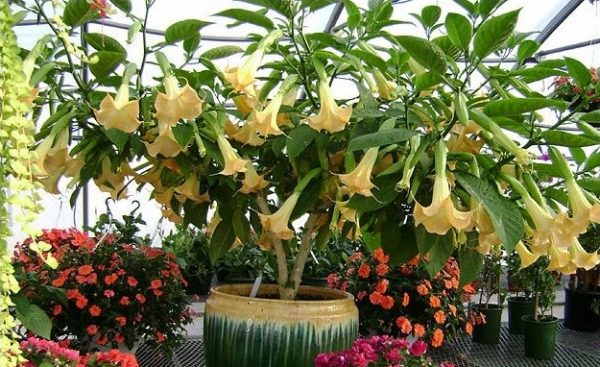
This is what Brugmansia looks like in a greenhouse.
Brugmansia can be grown in different ways:
- Container method in the garden.
- Planting Brugmansia seedlings in open ground.
- If there is space - at home in the winter garden
Planting and caring for Brugmansia in pots in summer
Choosing pots. If you choose the method of growing Brugmansia in pots in the garden, you need to make sure that the containers are ceramic, with a volume of 10 - 15 liters or more, have thick walls and a light color. This will help prevent the roots from overheating. Plastic pots are also suitable, but they will make maintenance a little more difficult and will require light shade and increased watering.
What kind of soil is needed? A drainage made of gravel or expanded clay is placed at the bottom of the container. Brugmansia prefers fertile, light, non-acidic soils. The desired composition will be obtained by mixing one part of loam and humus with two parts of peat.
For planting, use Brugmansia seedlings grown from seeds or last year's plants that overwintered indoors. In any case, seedlings must be prepared for life in the open air.
We carry out hardening. Before planting Brugmansia, cups with seedlings are taken outside daily, first for 10 minutes, then increase the time to 1 - 2 hours. The outside temperature during “walks” should be above + 10, +15 degrees. Young shoots need to be shaded in the first few days and protected from drafts. The photo below shows the seedling being hardened off.
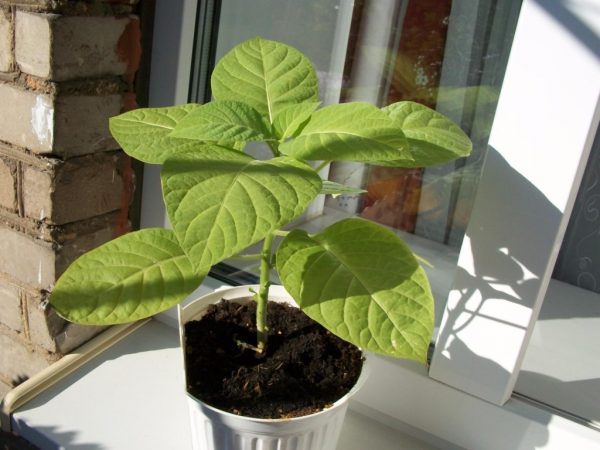
Before planting, seedlings must be hardened off.
If you spent the winter in the basement. Seedlings harvested for wintering in cool room, it is necessary to take it out into the light and warmth in February - early March, water it, and transplant it into a permanent pot. In April, you can start fertilizing with nitrogen fertilizer every two weeks before moving into the garden.They also need hardening. The procedure and conditions are the same as for hardening seedlings.
If you spent the winter in the house. Overwintered seedlings in a warm room, already have leaves and sometimes buds. To increase green mass, they benefit from fertilizing with nitrogen fertilizer. Hardening should be carried out with special care, since the plants are already quite large, and any gust of wind can damage them.
We move to the garden. It will be possible to leave plants in pots outside only if the air temperature at night does not drop below +7, + 8 degrees, since in cooler weather the development of Brugmansia stops, the leaves turn yellow and fall off, and recovery will take time.
The second half of May - early June is a safe period for planting plants in the garden for the whole summer. They will need a place that is well lit and protected from the wind.
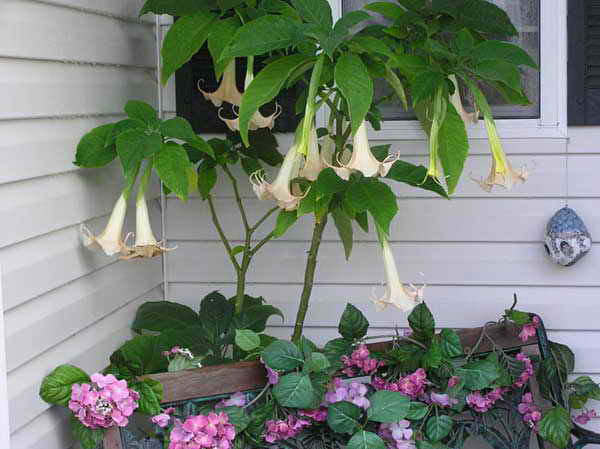
For Brugmansia it is better to choose a place protected from the wind.
How to care
Further care for Brugmansia in open ground consists of regular, abundant watering. At air temperatures above +25 degrees, spraying in the morning and evening is recommended. The resulting crust on the ground must be destroyed.
From spring to mid-summer, fertilizing is carried out every 10 days with complex mineral fertilizer with a predominance of potassium and phosphorus. Later, two feedings per month are enough.
Last year's plants bloom from June until the first frost, and those grown from seeds in winter bloom the following year. The readiness of the bush to flower is indicated by the formation of forks on the trunk. These areas must be maintained to have a prolific flowering plant.
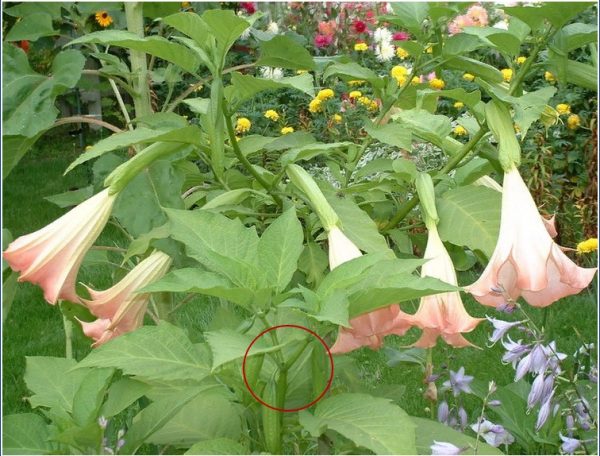
The photo shows the flowering zone on a young plant
Transfer. Young plants need to be replanted into larger containers every year, and adults - after 2 - 3 years.
Caring for Brugmansia in the house in winter
To preserve Brugmansia in winter, you need to think about how to create the necessary conditions:
- illumination similar in duration to sunlight on a summer day,
- humidity – 60 – 70%,
- temperature from +21 to +25 degrees,
- sufficient space.
It is necessary to take into account that the plant is voracious, it requires feeding every 5 days. These should be mineral fertilizers based on potassium and phosphorus or organic. It is advisable to alternate them.
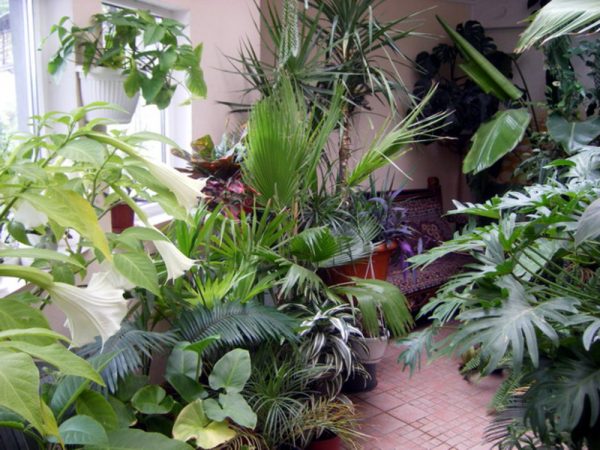
With good care and suitable conditions, Brugmansia can bloom in the house until December.
Nitrogen-containing fertilizers should be introduced only at the end of winter - beginning of spring, so as not to increase the green mass ahead of time. Fertilizers should be dissolved in warm water and watered, so they are well absorbed by the plant.
Planting and caring for Brugmansia in open ground
We choose a place. The plant loves the sun, but if it is scorching, it is worth considering the possibility of shading. The wind can easily break heavy grassy branches and tatter flowers. For these reasons, you need to choose a sunny and quiet place.
To plant Brugmansia in open ground, seedlings grown from seeds, rooted cuttings and perennial trees are used. All planting material must undergo a hardening procedure in the manner described above.
When to plant. Planting time is the third ten days of May - early June. The reference point is the air temperature, it should be consistently no lower than +5, +7 degrees at night and +15, +18 during the day.
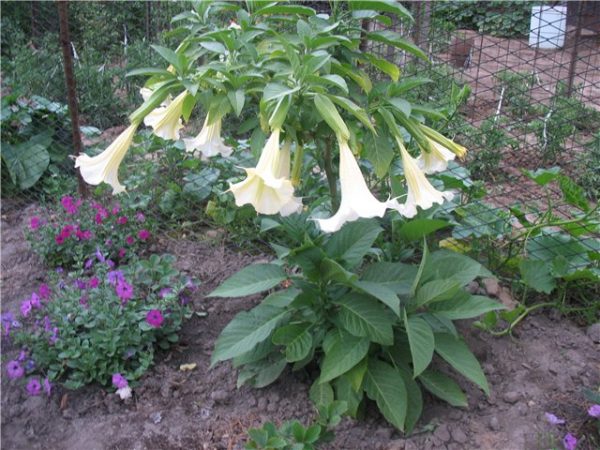
Brugmansia planted in open ground.
Pre-landing preparation. The diameter of the planting hole is 50 cm, the depth depends on the size of the plant, usually 70 - 80 cm.A drainage layer of small stones or gravel is placed at the bottom of the pit.
Brugmansia grows well in fertile, non-acidic soils, so you need to add compost or humus to the planting hole, and sand or peat as a loosening agent. Manure should not be used as it increases the acidity of the soil. The seedling must be filled strictly up to the root collar, otherwise the plant may die.
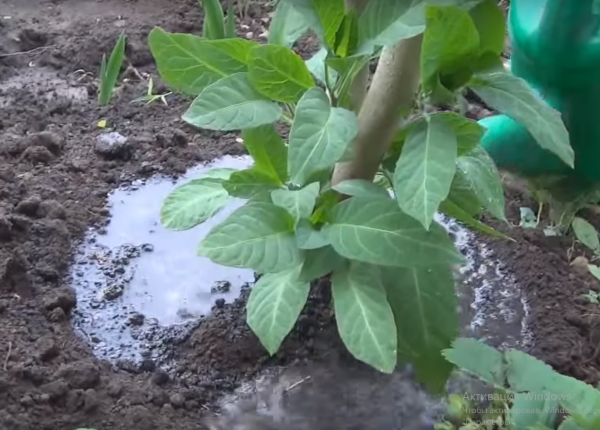
Planting overwintered Brugmansia in open ground
How to care. Brugmansia in open ground needs abundant and frequent watering, regular fertilizing with mineral fertilizers and organic matter. In the first month after planting and before the formation of a lush crown, fertilizers should contain nitrogen. Later, for abundant flowering, phosphorus-potassium fertilizers are used in alternation with organic ones. The application interval is 10 days.
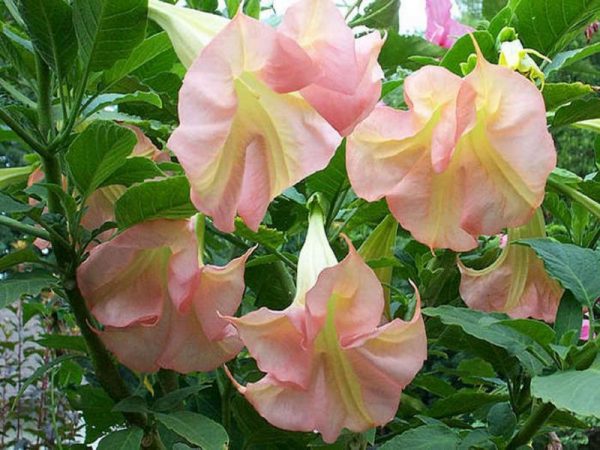
Plant Brugmansia in the garden and admire its huge flowers.
In hot regions, to create a “tropical” microclimate, Brugmansia is watered twice a day, and also sprayed carefully, without getting on the flowers. In rainy weather, watering can be reduced.
By mid-summer, the bushes grow greatly, the branches droop, and their appearance suffers. In this case, tying it to the supports will help.
In place of the flowers, pods with seeds are formed that must be removed. The plant spends a lot of effort on providing them, because of this the number of buds decreases and the decorative effect is lost.
Wintering Brugmansia when grown in open ground
In autumn it is time to prepare Brugmansia for wintering and transplant it into containers. You can use large plastic pots, plastic buckets, containers from building materials. In volume they should correspond to the roots of the plants.
Preparing the plant for winter
When to dig up Brugmansia. When cool weather sets in (+10, +12 degrees), the tree needs to be dug up, trimmed, placed in a container and winterized.
How to prune Brugmansia for the winter. First you need to cut off everything unnecessary and form a crown. If Brugmansia grew in the first summer and did not form flowering zones (forks on the trunk), but has one or two straight branches, then there is no need to prune anything, otherwise flowering will come too late next year.
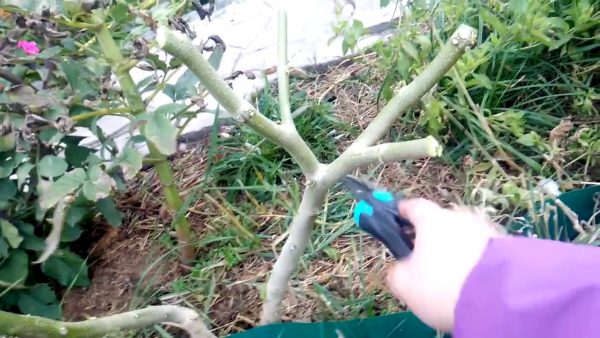
Autumn pruning of Brugmansia
In an adult bush, we cut off all straight-growing branches. They can be used for cuttings. The remaining trunk has several flowering zones (forks). All of them must be preserved, and pruning should be done 8 to 10 buds higher, then next year Brugmansia will bloom in early summer.
Brugmansias planted in tubs or pots are pruned in the same way.
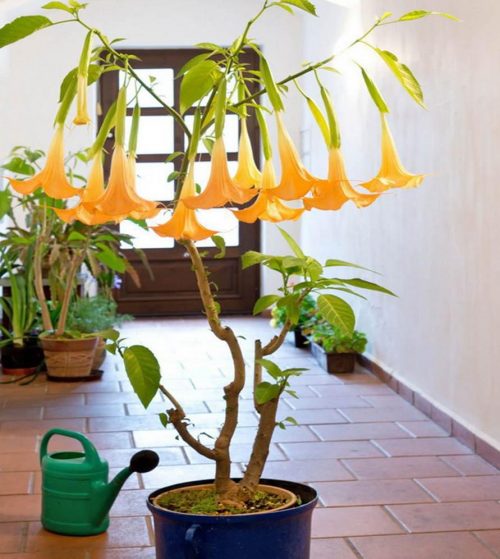
The photo shows Brugmansia, which was brought into the house for the winter.
Mature plants remain in the same containers. They are replanted after a couple of years. And the young ones need to be transferred to larger containers. Over the summer they have grown well, next year they will need new space and fresh nutritious soil.
Growing in open ground, the plant forms large roots. It’s not scary to cut them off when replanting, as the root system quickly recovers. The diameter of the earthen ball should correspond to the diameter of the pot, but the depth should be greater.
It is not necessary to make holes in the bottom of the bucket. In winter, Brugmansia is watered very sparingly, and it absorbs almost all the water. But to be on the safe side and in the case of your first growing experience, you should use a container with holes to avoid rotting of the roots.
Pour light fertile soil into the bottom of the pot, place the dug-out brugmansia there, if roots are visible, add soil, water.
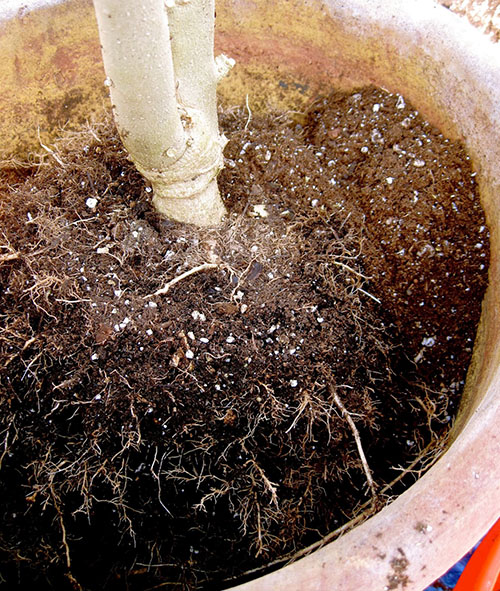
The diameter of the pot should correspond to the size of the roots
The pot with the plant can be left in the garden for a while. But if there is a threat of sudden cold snap or there is no way to quickly move it indoors, then you need to do this right away so as not to risk it.
Where to identify Brugmansia for the winter
There are several options for wintering the plant:
- You can place the plant in the basement or cellar. There, in the darkness and consistently cool temperature, Brugmansia is at rest and sheds its leaves. You only need to water it occasionally. In February - early March, the container is moved to light and warmth, prepared for vegetation and flowering, as described above.
- Veranda or insulated balcony. Here it is a little more difficult to create the necessary conditions - the temperature should not fall below +15, +12 degrees.
- Wintering in an apartment. This should be the coolest room, window sill or place away from heating devices. Brugmansia may shed its leaves, but moderate watering and treatment against insect pests must be continued. In March, we begin awakening - we provide the plant with warmth, watering, fertilizing and additional lighting. Brugmansia quickly comes to life and takes on a decorative appearance.
Wintering in an apartment should be done with extreme caution, especially if there are children, as the plant is poisonous.
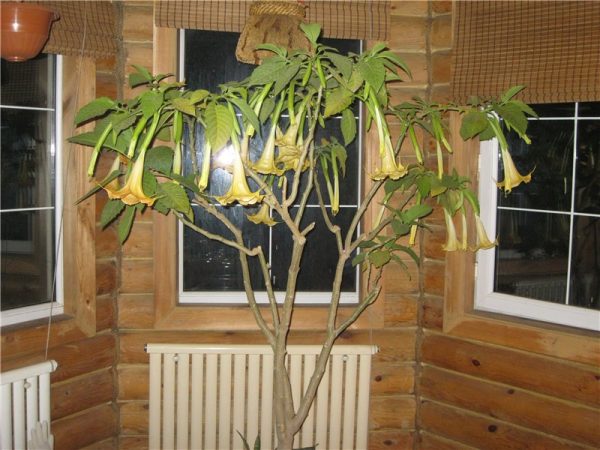
The plant can easily overwinter on a warm veranda
Not everyone has a basement or a spacious apartment into which they can bring a whole tree. Then do this: in the fall, cut the trunk almost to the root, leaving a few buds at the very bottom. Dig up the Brugmansia rhizome and plant it in a pot.A large pot will fit perfectly on the windowsill. The photo below shows that young shoots have already begun to grow from the root and the plant is doing quite well.

The easiest option for wintering
In about a month, the first shoots will appear, which will grow 50-60 centimeters over the winter. In spring, transplant the plant into the ground, but it will bloom only in August.
How to care for indoor Brugmansia
Caring for Brugmansia at home is not particularly difficult, but not everyone has a large enough area in their home to accommodate such a large plant.
In the summer, the pot with Brugmansia is moved to the balcony, where there is a lot of air and light. There is also a danger of overheating, as the temperature can rise above +28 degrees. In this case, the plant should receive sunlight in the morning, and shading during the day.
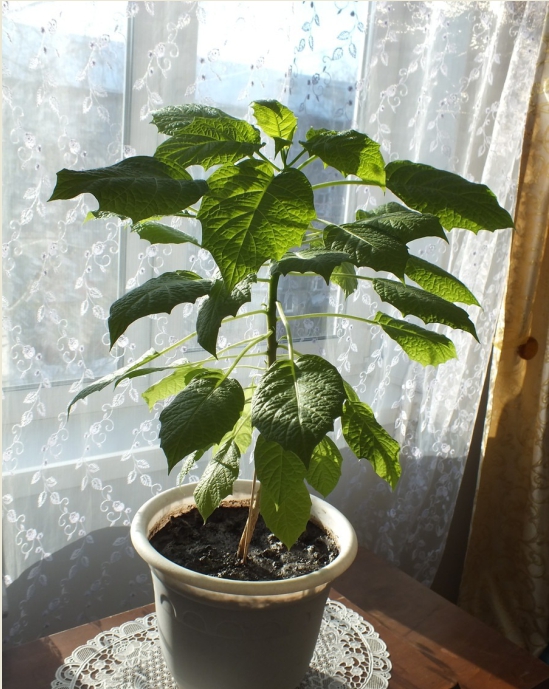
In the photo there is Brugmansia on the balcony
Watering in summer is required twice a day, spraying - in the morning and evening, fertilizing - every 7 days with mineral or organic fertilizers (alternate). To avoid the growth of leaves and branches to the detriment of flowering, do not use nitrogen-containing fertilizers.
Brugmansia returns to the apartment when the temperature drops to +5, +7 degrees.
Propagation of Brugmansia by cuttings
Growing Brugmansia from cuttings is a faster way to get a flowering plant with a guarantee of the qualities of the variety you like. Propagate by cuttings possible in autumn and spring. A seedling from autumn cuttings is preferable, since it will bloom next summer. Spring is only for next year.
Autumn cuttings
When pruning Brugmansia in the fall, it is necessary to select branches with a woody trunk. You can use green ones, but the result will be a little worse.It is necessary to prepare cuttings before frost, even a light frost will destroy Brugmansia, and cuttings from it will not take root.
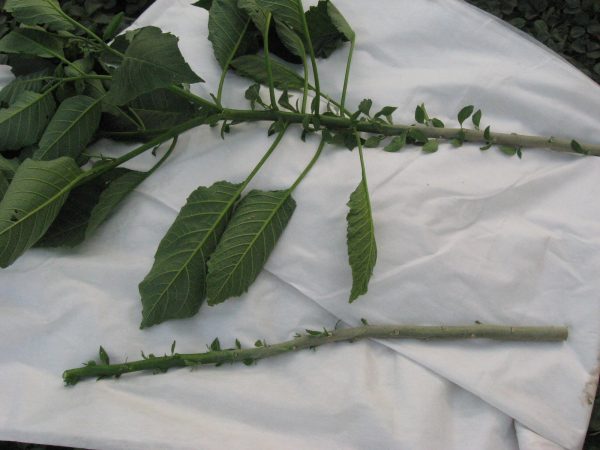
After autumn pruning, many shoots remain
The branches are cut into pieces with three to four buds. The length of the segments depends on the length of the internodes and can be different. A short piece, 3–4 cm, is also suitable for cuttings.
It is advisable to cut off large leaves; small and lateral shoots can be left.
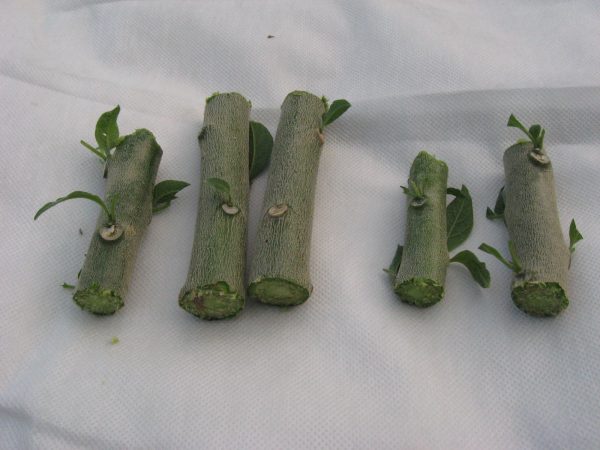
You should get cuttings like this
The cut cuttings are stuck into the soil with the addition of perlite. When rooting in a greenhouse, no shelter is required, but in an apartment it is better to cover the cuttings with film. The rooting process is quite long, up to 30 - 40 days, but almost all cuttings take root.
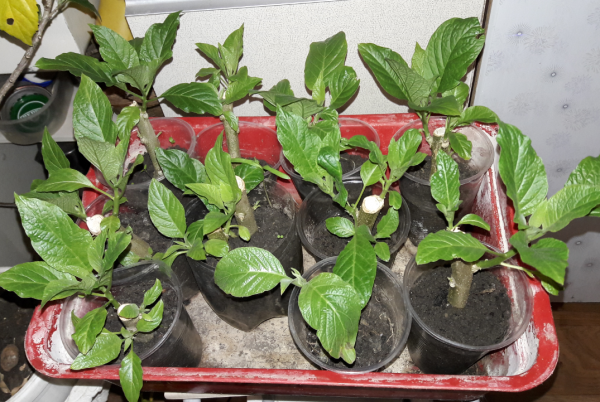
Usually cuttings root very well.
Good results are also obtained when rooting in water. The cuttings are placed in a container with a small amount of water. To prevent it from turning green, add crushed birch coals or 2 - 3 tablets of activated carbon. The container is left in the garden if it is still warm, or placed in a bright room.
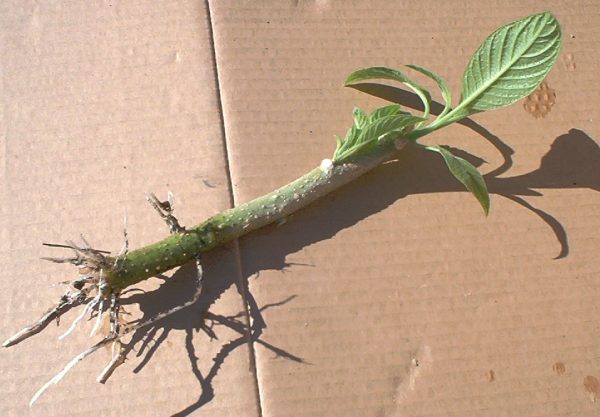
The rooted cutting is ready for planting in the ground.
After the roots grow, you need to transplant the cuttings into pots with soil, as for seedlings when picking. Further care consists of regular watering, fertilizing, additional lighting, and insecticide treatments to prevent pest damage. Such a seedling will bloom in its first summer.
Spring cuttings
The process occurs somewhat differently during spring reproduction. A young apical branch 20 cm long is used as a cutting. The lower leaves are cut off, the branch is placed in a container of water, and the top is covered with a plastic bottle without a bottom, neck up.The cuttings need to be sprayed daily so that they retain the leaves, so root formation will occur faster.
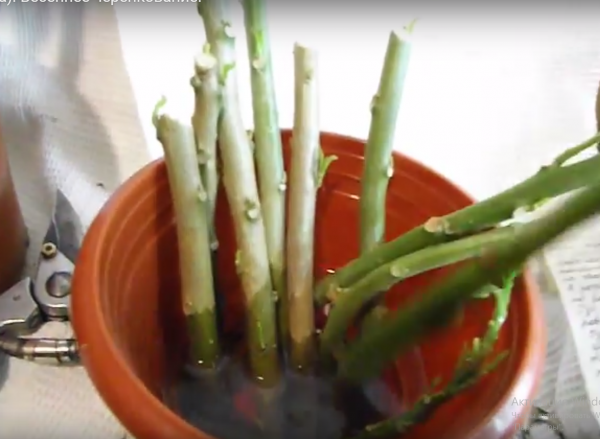
Spring cuttings are not much different from autumn ones
When roots appear, the cuttings are planted in the ground for rooting. Soil composition: sand and perlite, one part each, peat – two parts. After a couple of weeks, the seedling is ready to be transplanted to a permanent place in a pot or in a temporary container with nutritious soil if it is planned to be grown in open ground.
You might be interested: Propagation of clematis by cuttings, layering
Brugmansia pruning
In the summer, Brugmansias do not do any pruning. If the branches are too spread out, they are tied to pegs to give a more well-groomed appearance. The exception is the case when the grower wants to form a standard specimen.
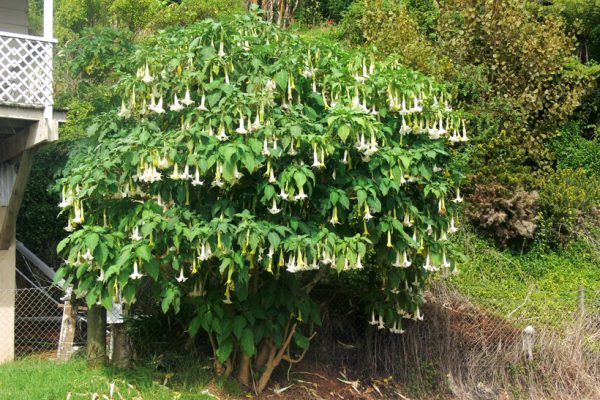
Brugmansia grew as a bush.
Brugmansias produce numerous stepsons, which is why they grow in the form of a bush. It looks nice too. But if you want, you can experiment.
To form a trunk, choose the largest, well-developed trunk. It is fixed on a straight peg, and everything else is cut off. As it grows, you need to constantly remove the shoots coming from the ground and the shoots that form on the trunk. The crown is grown without pruning until the formation of flowering zones - forks on the trunk. Such a “slingshot” indicates that the plant has reached maturity and is capable of blooming.
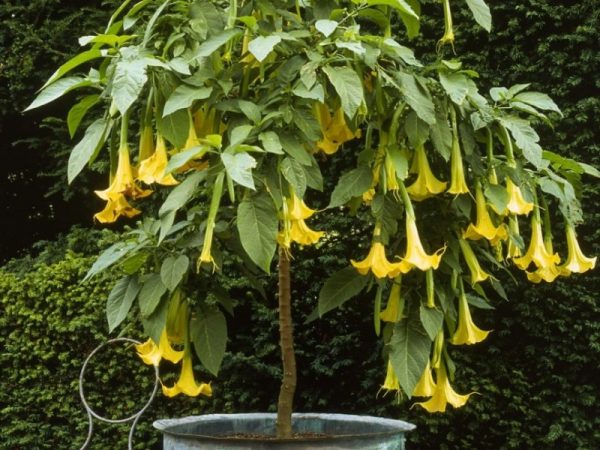
Formation into one trunk
During autumn pruning It is worth paying special attention to these “slingshots”. If they are removed, the Brugmansia will rejuvenate; it will again have to gain maturity and only then bloom at the end of summer. Properly pruned plants can produce up to three waves of flowering.
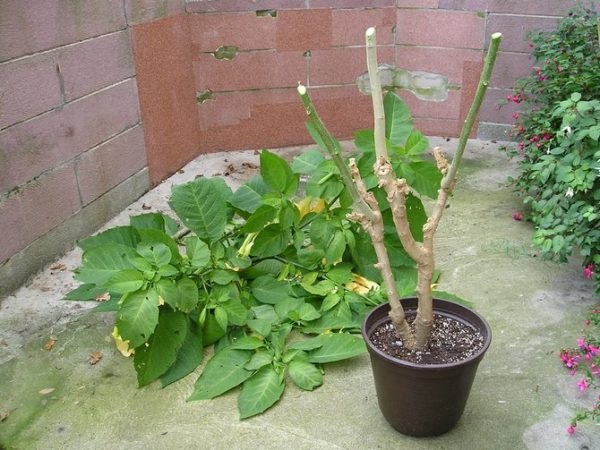
Autumn pruning
Straight-growing branches and stepsons can be safely removed spring and autumn, if they interfere or create an unkempt appearance.
The roots also need to be pruned. This avoids frequent transplanting into a larger container. The maximum and sufficient pot volume for an adult plant is 30 liters.
In the fall, when digging from open ground or when transplanting from one pot to another, Brugmansia is removed from the ground, small roots are cut off, and large ones are shortened. The same procedure can be done in the spring, but plants tolerate autumn pruning more easily.
Why do Brugmansia leaves turn yellow and fall off?
There are several reasons for yellowing leaves:
Adverse climatic conditions
Planting too early at low temperatures, below +7 degrees. If the seedling is in a pot, then it must be returned indoors and wait for warm days. If the plant is planted in the ground, then you need to wrap it with covering material and water it with hot, +40, +45 degrees, water.
High temperature, +35 and above, also causes yellowing and loss of leaves. In this case, frequent watering and spraying the entire bush with water will help. The procedure must be carried out at least twice a day.
Damage by insect pests
Brugmansia is attacked by spider mites, aphids and whiteflies.
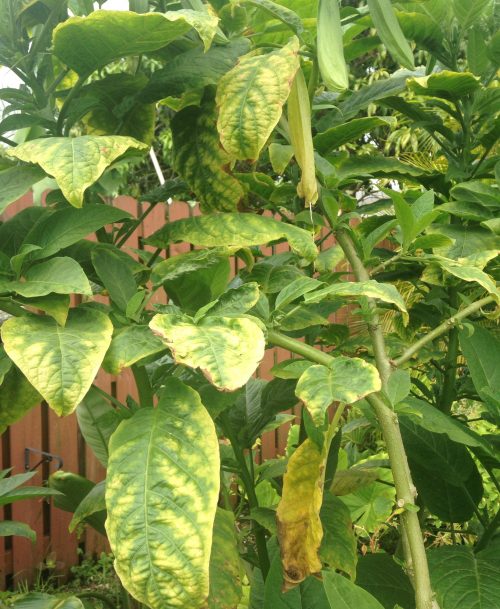
The cause of yellowing leaves is often insect pests.
This is very dangerous, as these insects are unusually prolific and aggressive. It is important to carry out preventive spraying with special preparations, regularly check the plants, examine suspicious leaves from the underside through a magnifying glass, and take control measures in a timely manner.
Lack of nutrition
Yellow leaves indicate a lack of nitrogen, which has been washed away by frequent watering.Brugmansias suffer the most from this in containers where the soil is compacted due to overgrown roots, and the plants do not receive the required amount of microelements. To prevent this from happening, you need to fertilize every 10 to 14 days and alternate the application of mineral and organic fertilizers.
Why doesn't Brugmansia bloom?
You should not expect flowering in the first season from Brugmansia grown from seeds or from spring cuttings. Most of these plants bloom in the second year, and some in the third.
Brugmansias of terry varieties develop noticeably more slowly. Their flowering period is the third – fourth season.
Incorrect autumn pruning will also leave the bush without flowering, or it will come by the end of summer. When pruning, it is necessary to preserve all the forks (slingshots) on the trunks, then Brugmansia will throw out buds more than once during the season.
You should not try to shape the bush in the summer, do pinching or pruning. Brugmansia forms a crown on its own, and intervention will lead to the shedding of buds.
Irregular watering and fertilizing, overdrying of the soil, untimely destruction of insects will weaken the plant, which will certainly affect flowering
Diseases and pests
With proper care, Brugmansia rarely gets sick, but with high humidity, gray rot can develop. This fungal disease appears as gray spots on the leaves and green part of the trunk. Spraying with fungicide solutions (Topaz, Agat-25K, AbigaPik, Vitaros, etc.) will help.
Very dangerous for the plant spider mite. Its colonies are located on the bottom of the leaf and are not immediately noticeable. Upon examination, small yellow dots are visible on the surface of the leaf, and on the reverse side there is a web with numerous insects and larvae.It is urgent to treat Brugmansia, nearby plants and the soil around with Aktelik, Fitoverm, BI-58, etc. Repeat treatments 3-4 times with an interval of five days.
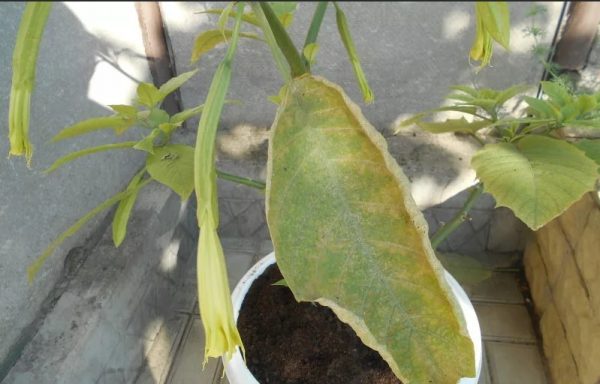
Mite on leaves
Whiteflies are microscopic flies that also settle on the lower surface of the leaf. Lesions in the form of small yellow lines are visible from above. Insects reproduce very quickly. Fitoverm, Aktara, Aktelik, etc. will help you get rid of them.
Aphids attack young leaves and twigs and suck the juice out of them. These insects can be easily detected by the curled leaves of the plant and begin to fight immediately. Tanrek, Biotlin, etc. are used against aphids.
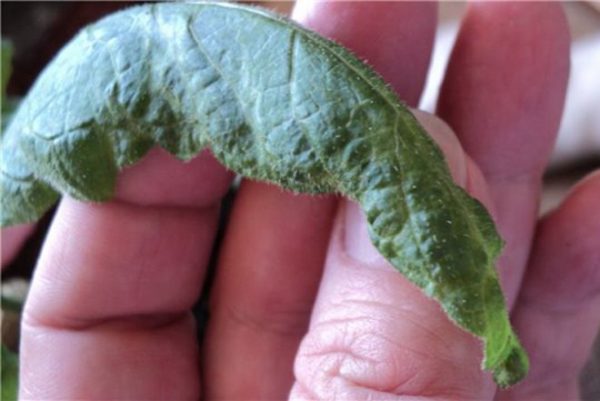
Aphid
When moving for the winter, the leaves must be carefully inspected and sprayed, as pests can enter a room where treatment is difficult.
Inspections and preventative spraying should be carried out regularly in winter in order to get a strong and healthy plant in the spring. Brugmansia will thank you for your care and attention, and will give its beauty for many years.
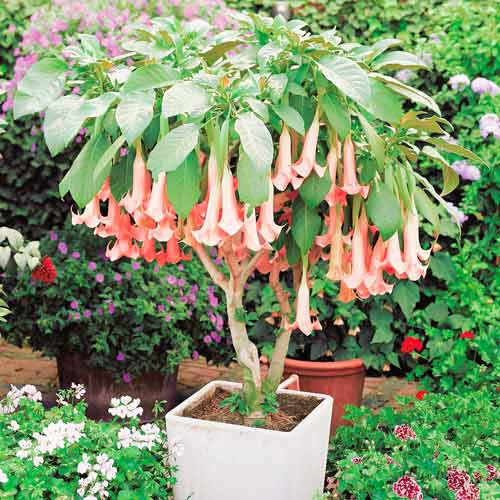
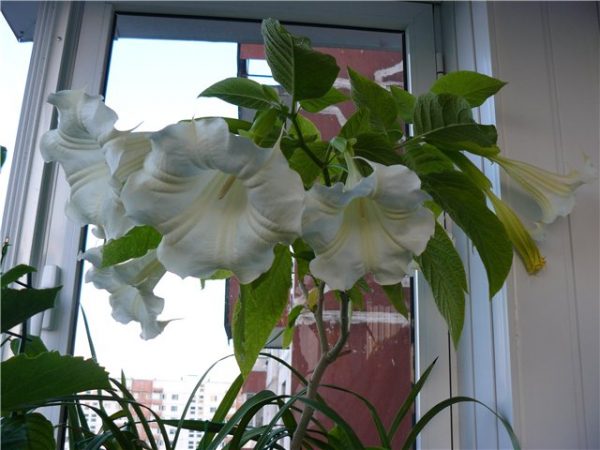
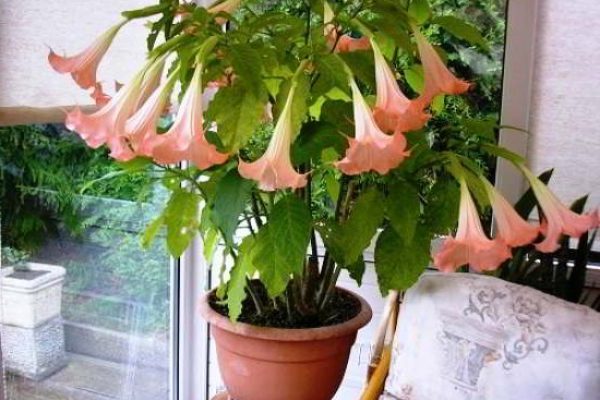
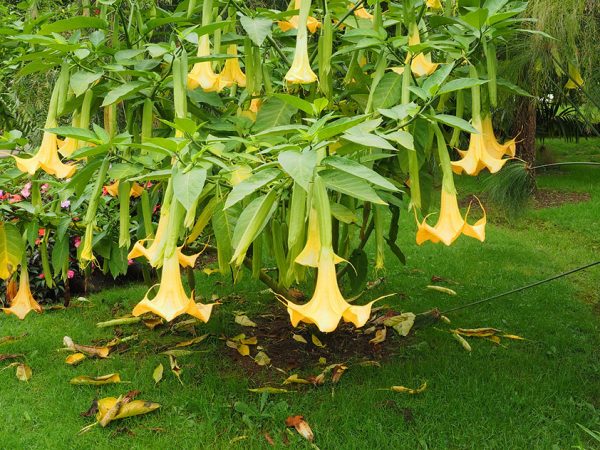
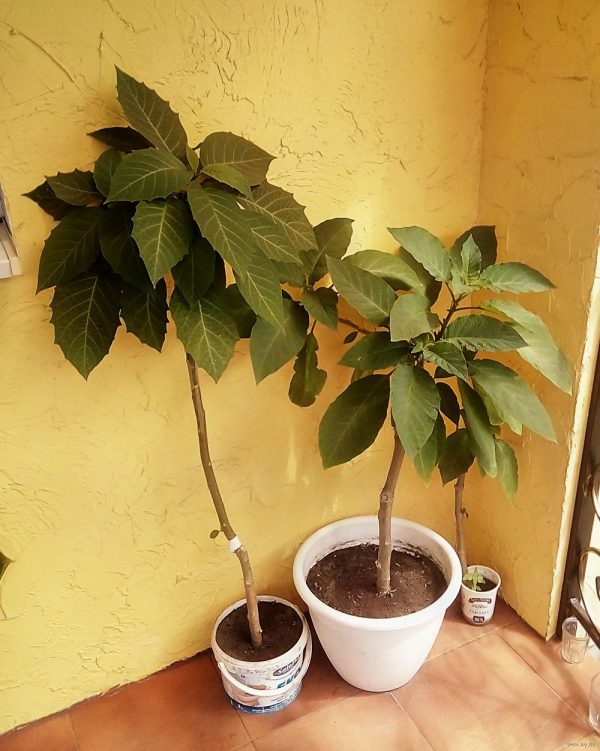
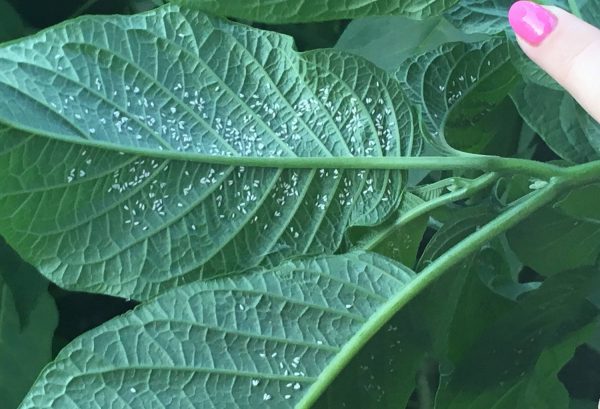


 CUCUMBERS NEVER GET SICK, I'VE BEEN USING ONLY THIS FOR 40 YEARS! I SHARE A SECRET WITH YOU, CUCUMBERS ARE LIKE THE PICTURE!
CUCUMBERS NEVER GET SICK, I'VE BEEN USING ONLY THIS FOR 40 YEARS! I SHARE A SECRET WITH YOU, CUCUMBERS ARE LIKE THE PICTURE! You can dig a bucket of potatoes from each bush. Do you think these are fairy tales? Watch the video
You can dig a bucket of potatoes from each bush. Do you think these are fairy tales? Watch the video
 How our fellow gardeners work in Korea. There is a lot to learn and just fun to watch.
How our fellow gardeners work in Korea. There is a lot to learn and just fun to watch. Eye trainer. The author claims that with daily viewing, vision is restored. They don't charge money for views.
Eye trainer. The author claims that with daily viewing, vision is restored. They don't charge money for views. A 3-ingredient cake recipe in 30 minutes is better than Napoleon. Simple and very tasty.
A 3-ingredient cake recipe in 30 minutes is better than Napoleon. Simple and very tasty. Therapeutic exercises for cervical osteochondrosis. A complete set of exercises.
Therapeutic exercises for cervical osteochondrosis. A complete set of exercises. Which indoor plants match your zodiac sign?
Which indoor plants match your zodiac sign? What about them? Excursion to German dachas.
What about them? Excursion to German dachas.